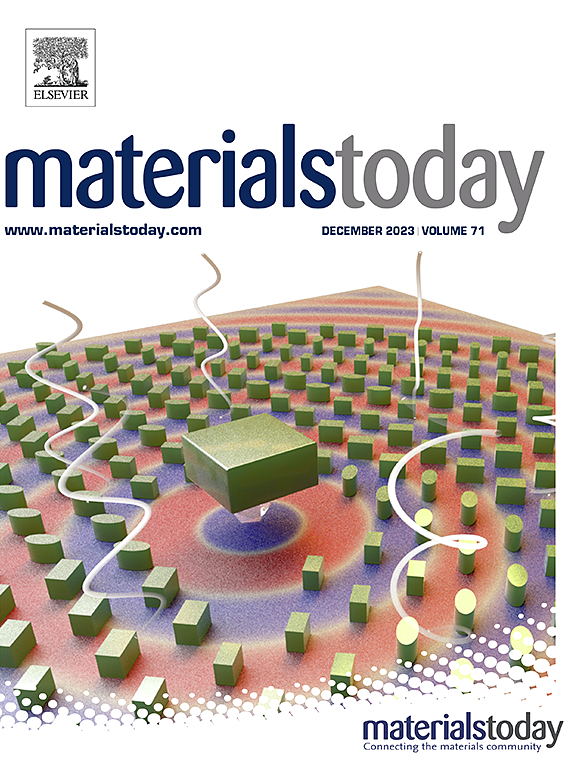An architecting binder derived from Antarctic red algae to accelerate sulfur redox kinetics in Li–S batteries
IF 21.1
1区 材料科学
Q1 MATERIALS SCIENCE, MULTIDISCIPLINARY
引用次数: 0
Abstract
Volume changes during charge/discharge cycles can lead to substantial cracking, disrupting electron and ion transfer channels, and hindering the performance of lithium–sulfur (Li–S) batteries. Binders are crucial for mitigating these issues because they preserve the structural integrity of electrodes and ensure reliable operation. Herein, this study presents the first report of a hybrid carrageenan, Antarctic macroalgae Curdiea racovitzae-derived polysaccharide (CRP), consisting of a diverse-blocked copolymer including kappa, iota, mu, nu carrageenans, and porphyran as Li–S battery binders. CRP prevents binder agglomeration and enables the electrode to form a uniform 3D-network structure reminiscent of an ant tunnel, enhancing the electrolyte permeability and utilization of the sulfur species. Additionally, the abundant functional groups in CRP, such as sulfate and hydroxyl groups, facilitate efficient Li-ion transport. By leveraging these properties, the CRP-based sulfur electrode achieves a high initial capacity of ∼1500 mAh g−1 at 0.1C, approximately 90 % of the theoretical capacity, and demonstrates superior cycle stability at 1C. Moreover, the Li2S nucleation rate was nearly 100 times higher compared to the PVDF-based sulfur electrode. The incorporation of a sustainable CRP binder in Li–S batteries marks a notable breakthrough, paving the way for future developments in the battery field.

从南极红藻中提取的一种结构粘合剂,可加速锂硫电池中硫的氧化还原动力学
充放电循环过程中的体积变化会导致严重的开裂,破坏电子和离子传递通道,影响锂硫电池的性能。粘合剂对于缓解这些问题至关重要,因为它们可以保持电极的结构完整性并确保可靠的操作。本文首次报道了一种由kappa、iota、mu、nu、卟啉等多种嵌段共聚物组成的杂化卡拉胶——南极大藻Curdiea racovitzae-derived多糖(CRP)作为锂- s电池的粘结剂。CRP可防止粘结剂团聚,使电极形成类似蚂蚁隧道的均匀3d网络结构,从而提高电解质的渗透率和硫的利用率。此外,CRP中丰富的官能团,如硫酸盐和羟基,促进了锂离子的有效运输。通过利用这些特性,基于crp的硫电极在0.1C时获得了约1500 mAh g - 1的高初始容量,约为理论容量的90%,并且在1C下表现出优异的循环稳定性。此外,与pvdf基硫电极相比,Li2S成核速率提高了近100倍。在Li-S电池中加入可持续CRP粘合剂标志着一个显著的突破,为电池领域的未来发展铺平了道路。
本文章由计算机程序翻译,如有差异,请以英文原文为准。
求助全文
约1分钟内获得全文
求助全文
来源期刊

Materials Today
工程技术-材料科学:综合
CiteScore
36.30
自引率
1.20%
发文量
237
审稿时长
23 days
期刊介绍:
Materials Today is the leading journal in the Materials Today family, focusing on the latest and most impactful work in the materials science community. With a reputation for excellence in news and reviews, the journal has now expanded its coverage to include original research and aims to be at the forefront of the field.
We welcome comprehensive articles, short communications, and review articles from established leaders in the rapidly evolving fields of materials science and related disciplines. We strive to provide authors with rigorous peer review, fast publication, and maximum exposure for their work. While we only accept the most significant manuscripts, our speedy evaluation process ensures that there are no unnecessary publication delays.
 求助内容:
求助内容: 应助结果提醒方式:
应助结果提醒方式:


